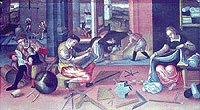
The Measurers:
a Flemish Image of Mathematics in the Sixteenth Century
Catalogue
The Mathematicians: catalogue nos 1 to 12
The Measurers: catalogue nos 13 to 39
The Collectors: catalogue nos 40 to 47
The Measurers
13 14 15 16 17 18 19 20
21 22 23 24 25
26 27 28 29 30 31 32 33 34 35 36 37
38 39
12. Utriusque astrolabii tam particularis quam universalis fabrica et usus
Authors: G. Stempel and A. Zeelst
Printed at Liège, in 1602
The authors associate the 'particular' astrolabe with Johann Stöffler and the 'universal' with
Gemma Frisius. It has been suggested that the instrument maker Zeelst was responsible only for
engraving the plates (Rooseboom, p.133) but he is partnered with Stempel on the title-page and
in signing the dedication.
13. Polyhedral dial
Signed: M.C.K.C.R.P.
Dated: 1691
A German instrument in brass with seven faces and seven dials, projected for latitude 47 degrees
30 minutes.
Length: 152 mm
Lewis Evans Collection G. 565
14. Horary quadrant
17th century?
An English quadrant of an unusual design, for finding the time from the altitude of the sun, with
two fixed sights, a plumb-line and sliding bead. Any altitude can be taken with the degree scale
on the rim.
Radius: 200 mm
Billmeir Collection
Accession no. 57-84/194
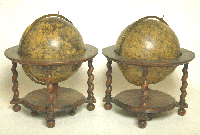
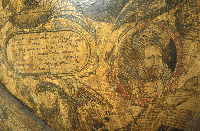
15. Pair of globes
Signed: Guilhelmus Ianssonius Blaeu
The terrestrial globe is dated 1599 and the celestial 1603, but the information on the terrestrial
globe indicates that it is a later edition, after 1618. The terrestrial globe is dedicated to the
Governors of the Estates-General of the Netherlands and the celestial to the Prince of Orange.
The celestial globe is derived from the observations of Tycho Brahe, supplemented by the those
of Frederik de Houtman made in the southern hemisphere during the first Dutch voyage to the
East Indies. Blaeu had worked under Tycho at Uraniborg and has included a portrait of the
Danish astronomer on the celestial globe.
Diameters: 395mm
Bequeathed by J.A. Gotch
Accession no. 42-6
16. Square
18th century?
A simple brass square with shaped ends.
Length: 155 mm
Inventory no. 1001
17. Compasses
18th century?
Compasses with shaped brass legs and steel points.
Length: 160 mm
Lewis Evans Collection
Inventory no. 1004
18. Rule
Signed: J A Hallensen Icte. et Pract: des Sciences Mathematiqu: Inventeur. les a fait.
Dated: Wolfenb. [Wolfenbüttel] 1748
A brass rule marked with a linear scale along one edge and engraved on the face with a diagonal
scale of the Paris foot.
Length: 384 mm
Inventory no. 1006
19. Compasses
17th century
A large pair of brass compasses with steel points; one is detachable and can be replaced by a
drawing-pen. Threaded steel arc along which one leg is moved by a decorated brass
wing-nut.
Length: 245 mm
Billmeir Collection
Accession no. 57-84/254
20. Builder's level
18th century
An eighteenth-century mason's level, made in wood, of exactly the type illustrated in The
Measurers, demonstrating the longevity of some simple instrument designs.
Length: 1.57 m
Inventory no. 1005
21. Balance
An English equal-arm balance of around 1800 with steel arm and index and brass pans. Although
much later than the instrument illustrated in the picture, it is similar in design. The case has a
trade label for Mary De Grave.
Beam length: 345 mm
Accession no. 44-13
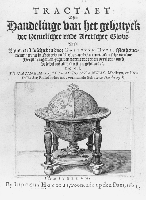 22. Tractaet, ofte handelinge van het gebruyck der hemelscher ende aertscher
globe
22. Tractaet, ofte handelinge van het gebruyck der hemelscher ende aertscher
globe
Author: Robert Hues
Printed at Amsterdam, in 1623
A new edition and translation from Latin to Dutch by Johannes Isacius Pontanus of the
Tractatus de globis by the English mathematician Robert Hues, first published in 1594.
The Dutch edition was published by Hondius.
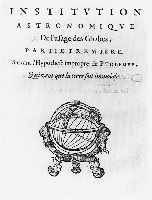 23. Institution astronomique de l'usage des globes et spheres celestes et terrestres, comprise
en deux parties, l'une, suivant l'hypothese de Ptolomee, qui veut que la terre soit immobile;
l'autre, selon l'intention de N. Copernicus, qui tient que la terre est mobile
23. Institution astronomique de l'usage des globes et spheres celestes et terrestres, comprise
en deux parties, l'une, suivant l'hypothese de Ptolomee, qui veut que la terre soit immobile;
l'autre, selon l'intention de N. Copernicus, qui tient que la terre est mobile
Author: Guillaume [W.J.] Blaeu
Printed at Amsterdam, in 1642
Blaeu divides his book into two sections - one assuming a stationary earth, the other adopting
the Copernican hypothesis of the earth in motion - but he makes it clear that the latter represents
his preference.
24. Recorder
By John Cousen, Huddersfield
c.1975
Treble recorder based on an illustration by Praetorius of 1619.
Length: 444 mm.
On loan from the Montagu Collection
25. Drum.
Reproduction baroque side drum.
Length: 520 mm, diameter: 459 mm.
On loan from the Montagu Collection.
26. Drumstick.
Length: 265 mm.
On loan from the Montagu Collection
27. Het Ierste Musyck Boexken.
Two part books, superius and tenor, the original edition being by Tielman Susato, Antwerp,
1551; the reproduction edition by Eugeen Schreurs and Martine Sanders (Peer, Belgium,
1989).
On loan from the Montagu Collection.
28. Standard weight
Marked: ANo DO 1588 EL Ao REG XXXo
An English bell-shaped 28-lb weight. In 1588, when Elizabeth I reformed the system of weights
on the avoirdupois standard, sets of standard weights were made for use throughout the
country.
Height: 200 mm
On loan from the Ashmolean Museum
29. Gauging rod
18th century
A jointed hardwood rule in three sections, with brass hinges, end pieces and inlaid
numbers.
Length: 1.1 m
Inventory no. 1002
30. Quart measure
Signed: De Grave London
Dated: 1817
An example of the Winchester quart measure, made for the 'Hundred of Rhyddland, County of
Flint'.
Height: 168 mm
Inventory no. 1003
31. Gallon measure
Dated: UNIV: OXON. 1737
A Queen Anne wine gallon measure. An Act of Parliament of 1706 defined the wine gallon
(which was different from the ale gallon) as: 'any round vessel (commonly called a cylinder)
having an even bottom and being 7 inches in diameter and 6 inches deep ... or any vessel
containing 231 in3 and no more' (Connor, p. 163).
Height: 175 mm; diameter: 190 mm
On loan from the Ashmolean Museum
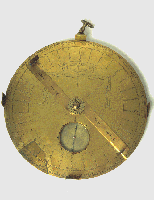 32. Holland circle
32. Holland circle
Dated: 1565
A surveying instrument of a type known as a 'Holland circle', Dutch, made in brass. Its basic
application is to measuring bearings with the pivoted alidade moving over three alternative scales
- a
circumferential degree scale, 32 points of the compass, named in Dutch and subdivided to
degrees, or
a double shadow square. The compass points were probably more familiar to the traditional
surveyor
than the scale only in degrees. An inset magnetic compass, with a target line offset for variation,
is for
orienting the instrument when taking bearings. In addition to the two pivoted sights, four fixed
ones
can form a surveyor's square. A shackle and suspension ring can be used to hang the instrument
vertically, when the alidade will indicate altitudes on the degree scale or the shadow square and
two
of the fixed sights will give the level. An inscription, 'DeLIneaVIt refeCItqVe MICheL
brVXeLLIs',
added to the alidade in modern times records the ownership of the collector Henri Michel and,
in the
form of a chronogram, the date 1930, which probably dates the fitting of the new alidade.
Diameter: 350 mm
Michel Collection; Billmeir Collection
Accession no. 57-84/125
33. Quadrant
c. 1700?
This English instrument is not a surveying quadrant, but its size is appropriate to the one in
The
Measurers and, with its fixed sights, plumb-line and degree and shadow-square scales on the
rim,
it could be used for measuring altitudes. Its main purpose, however, was for finding the time
from the
altitude of the sun. With a wooden case covered with tooled leather.
Radius: 300 mm
Lewis Evans Collection 5
34. Bushel measure
Dated: UNIVERSITAS OXON 1670
The Winchester bushel was a standard for dry goods introduced in the reign of Henry VII, but
first mentioned in statutes by an Act of 1670, the date on this example. For centuries the
Universities of Oxford and Cambridge were responsible for checking trading measures used in
their respective localities and so needed to have standard measures.
Diameter: 490 mm
On loan from the Ashmolean Museum.
35. Peck measure
The peck is a quarter bushel. This example was formerly in the possession of the Clerks of the
Market in Oxford and was deposited in the Ashmolean Museum in 1866.
Diameter: 372 mm
On loan from the Ashmolean Museum
36. Ell rule
Dated: 1786
An oak rule, thought to be German, with a shaped handle and brass fittings indicating two
different ells on opposite faces of the rule.
Length: 834 mm
Accession no. 77-21
37. Ell rule
18th century?
Wooden rule, possible Scandinavian, with triangular cross-section and metal end pieces. Divided
by brass insets into eighths and sixteenths. The rule has decorative carving on each face,
including an alphabet on one, and among the carved shapes is a pair of scissors.
Length: 542 mm
Accession no. 77-22
38. Scissors
Spring-mounted steel scissors, of the type depicted in The Measurers.
Length: 129 mm
Loaned from the Montagu Collection.
39. Yard rule
A wooden yard of octagonal cross-section with brass end caps.
Length: 915 mm
Inventory no. 1007
The Mathematicians: catalogue nos 1 to 12
The Collectors: catalogue nos 40 to 47
Contents
(c) Museum of the History of Science, Broad Street, Oxford, England.



 22. Tractaet, ofte handelinge van het gebruyck der hemelscher ende aertscher
globe
22. Tractaet, ofte handelinge van het gebruyck der hemelscher ende aertscher
globe 23. Institution astronomique de l'usage des globes et spheres celestes et terrestres, comprise
en deux parties, l'une, suivant l'hypothese de Ptolomee, qui veut que la terre soit immobile;
l'autre, selon l'intention de N. Copernicus, qui tient que la terre est mobile
23. Institution astronomique de l'usage des globes et spheres celestes et terrestres, comprise
en deux parties, l'une, suivant l'hypothese de Ptolomee, qui veut que la terre soit immobile;
l'autre, selon l'intention de N. Copernicus, qui tient que la terre est mobile 32. Holland circle
32. Holland circle